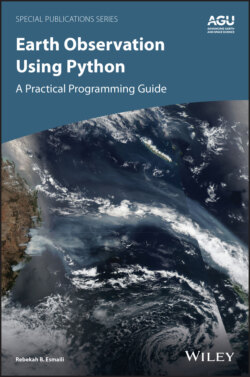Earth Observation Using Python

Реклама. ООО «ЛитРес», ИНН: 7719571260.
Оглавление
Rebekah B. Esmaili. Earth Observation Using Python
Table of Contents
List of Tables
List of Illustrations
Guide
Pages
EARTH OBSERVATION USING PYTHON. A Practical Programming Guide
FOREWORD
ACKNOWLEDGMENTS
INTRODUCTION
1 A TOUR OF CURRENT SATELLITE MISSIONS AND PRODUCTS
1.1 History of Computational Scientific Visualization
1.2 Brief Catalog of Current Satellite Products
1.2.1 Meteorological and Atmospheric Science
1.2.2 Hydrology
1.2.3 Oceanography and Biogeosciences
1.2.4 Cryosphere
1.3 The Flow of Data from Satellites to Computer
1.4 Learning Using Real Data and Case Studies
1.5 Summary
References
2 OVERVIEW OF PYTHON
2.1 Why Python?
2.2 Useful Packages for Remote Sensing Visualization
2.2.1 NumPy
2.2.2 Pandas
2.2.3 Matplotlib
2.2.4 netCDF4 and h5py
2.2.5 Cartopy
2.3 Maturing Packages
2.3.1 xarray
2.3.2 Dask
2.3.3 Iris
2.3.4 MetPy
2.3.5 cfgrib and eccodes
2.4 Summary
References
3 A DEEP DIVE INTO SCIENTIFIC DATA SETS
3.1 Storage
3.1.1 Single Values
3.1.2 Arrays
3.2 Data Formats
3.2.1 Binary
3.2.2 Text
3.2.3 Self‐Describing Data Formats
3.2.4 Table‐Driven Formats
3.2.5 geoTIFF
3.3 Data Usage
3.3.1 Processing Levels
3.3.2 Product Maturity
3.3.3 Quality Control
3.3.4 Data Latency
3.3.5 Reprocessing
3.4 Summary
References
4 PRACTICAL PYTHON SYNTAX
4.1 “Hello Earth” in Python
4.2 Variable Assignment and Arithmetic
4.3 Lists
4.4 Importing Packages
4.5 Array and Matrix Operations
4.6 Time Series Data
4.7 Loops
4.8 List Comprehensions
4.9 Functions
4.10 Dictionaries
4.11 Summary
References
5 IMPORTING STANDARD EARTH SCIENCE DATASETS
5.1 Text
5.2 NetCDF
5.2.1 Manually Creating a Mask Variable Using True and False Values
5.2.2 Using NumPy Masked Arrays to Filter Automatically
5.3 HDF
5.4 GRIB2
5.5 Importing Data Using Xarray
5.5.1 netCDF
5.5.2 Examining Vertical Cross Sections
5.5.3 Examining Horizontal Cross Sections
5.5.4 GRIB2 using Cfgrib
5.5.5 Accessing Datasets Using OpenDAP
5.6 Summary
References
6 PLOTTING AND GRAPHS FOR ALL
6.1 Univariate Plots
6.1.1 Histograms
6.1.2 Barplots
6.2 Two Variable Plots
6.2.1 Converting Data to a Time Series
6.2.2 Useful Plot Customizations
6.2.3 Scatter Plots
6.2.4 Line Plots
6.2.5 Adding Data to an Existing Plot
6.2.6 Plotting Two Side‐by‐Side Plots
6.2.7 Skew‐T Log‐P
6.3 Three Variable Plots
6.3.1 Filled Contour Plots
6.3.2 Mesh Plots
6.4 Summary
References
7 CREATING EFFECTIVE AND FUNCTIONAL MAPS
7.1 Cartographic Projections. 7.1.1 Geographic Coordinate Systems
7.1.2 Choosing a Projection
7.1.3 Some Common Projections
7.1.3.1. Plate Carrée
7.1.3.2. Equidistant Conic
7.1.3.3. Orthographic
7.2 Cylindrical Maps
7.2.1 Global Plots
7.2.2 Changing Projections
7.2.3 Regional Plots
7.2.4 Swath Data
7.2.5 Quality Flag Filtering
7.3 Polar Stereographic Maps
7.4 Geostationary Maps
7.5 Creating Maps from Datasets Using OpenDAP
7.6 Summary
References
8 GRIDDING OPERATIONS
8.1 Regular One‐Dimensional Grids
8.2 Regular Two‐Dimensional Grids
8.3 Irregular Two‐Dimensional Grids
8.3.1 Resizing
8.3.2 Regridding
8.3.3 Resampling
8.4 Summary
References
9 MEANINGFUL VISUALS THROUGH DATA COMBINATION
9.1 Spectral and Spatial Characteristics of Different Sensors
9.2 Normalized Difference Vegetation Index (NDVI)
9.3 Window Channels
9.4 RGB
9.4.1 True Color
9.4.2 Dust RGB
9.4.3 Fire/Natural RGB
9.5 Matching with Surface Observations
9.5.1 With User‐Defined Functions
9.5.2 With Machine Learning
9.6 Summary
References
10 EXPORTING WITH EASE
10.1 Figures
10.2 Text Files
10.3 Pickling
10.4 NumPy Binary Files
10.5 NetCDF
10.5.1 Using netCDF4 to Create netCDF Files
10.5.2 Using Xarray to Create netCDF Files
10.5.3 Following Climate and Forecast (CF) Metadata Conventions
10.6 Summary
11 DEVELOPING A WORKFLOW
11.1 Scripting with Python
11.1.1 Creating Scripts Using Text Editors
11.1.2 Creating Scripts from Jupyter Notebook
11.1.3 Running Python Scripts from the Command Line
11.1.4 Handling Output When Scripting
11.2 Version Control
11.2.1 Code Sharing though Online Repositories
11.2.2 Setting up on GitHub
11.3 Virtual Environments
11.3.1 Creating an Environment
11.3.2 Changing Environments from the Command Line
11.3.3 Changing Environments in Jupyter Notebook
11.4 Methods for Code Development
11.5 Summary
References
12 REPRODUCIBLE AND SHAREABLE SCIENCE
12.1 Clean Coding Techniques
12.1.1 Stylistic Conventions
12.1.2 Tools for Clean Code
12.2 Documentation
12.2.1 Comments and Docstrings
12.2.2 README File
12.2.3 Creating Useful Commit Messages
12.3 Licensing
12.4 Effective Visuals
12.4.1 Make a Statement
12.4.2 Undergo Revision
12.4.3 Are Accessible and Ethical
12.5 Summary
References
CONCLUSION
Appendix A INSTALLING PYTHON
A.1 Download Tutorials for This Book
A.2 Download and Install Anaconda
A.3 Package Management in Anaconda
Appendix B JUPYTER NOTEBOOK. B.1 Running on a Local Machine (New Coders)
B.2 Running on a Remote Server (Advanced)
B.3 Tips for Advanced Users
B.3.1 Customizing Notebooks with Configuration Files
B.3.2 Starting and Ending Python Scripts
B.3.3 Creating Git Commit Templates
Appendix C ADDITIONAL LEARNING RESOURCES
Appendix D TOOLS. D.1 Text Editors and IDEs
D.2 Terminals
Appendix E FINDING, ACCESSING, AND DOWNLOADING SATELLITE DATASETS
E.1 Ordering Data from NASA EarthData
E.2 Ordering Data from NOAA/CLASS
Appendix F ACRONYMS
INDEX
A
B
C
D
E
F
G
H
I
J
K
L
M
N
O
P
Q
R
S
T
U
V
W
X
Y
Z
WILEY END USER LICENSE AGREEMENT
Отрывок из книги
Special Publications 75
.....
Both GEO and LEO satellites can provide sea surface temperature (SST) observations. The GOES series of GEO satellites provides continuous sampling of SSTs over the Atlantic and Pacific Ocean basins. The MODIS instrument on the Aqua satellite has been providing daily, global SST observations continuously since the year 2000. Visible wavelengths are useful for detecting ocean color, particularly from LEO satellites, which are often observed at very high resolutions.
Additionally, LEO satellites can detect global sea‐surface anomaly parameters. Jason‐3 is a low‐Earth satellite developed as a partnership between EUMETSAT, NOAA, NASA, and CNES. The radar altimeter instrument on Jason‐3 is sensitive to height changes less than 4 cm and completes a full Earth scan every 10 days (Vaze et al., 2010).
.....